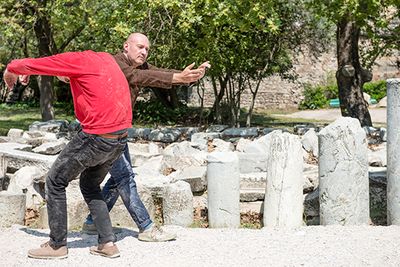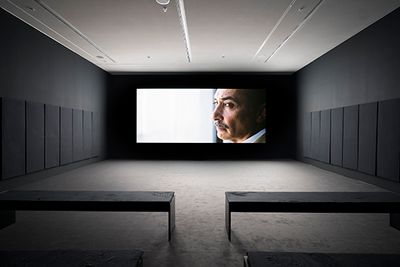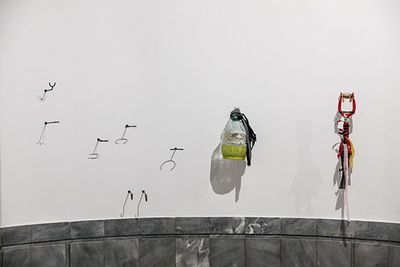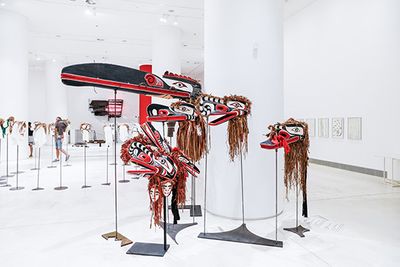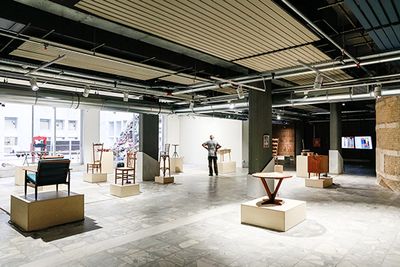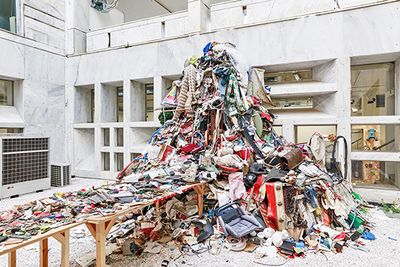Report: documenta 14 in Athens
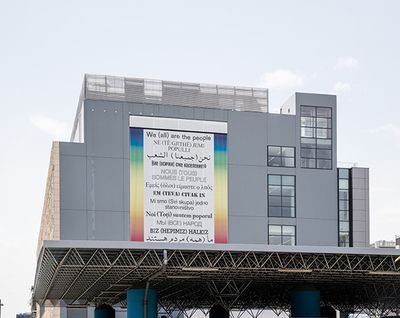
EMST—National Museum of Contemporary Art. documenta 14, Athens (8 April–16 July 2017). Courtesy Ocula. Photo: Charles Roussel.
For the first time in its long history, the mega exhibition of documenta—which takes place only every five years—is split across two cities: its usual host city of Kassel, Germany (10 June–17 September 2017) and Athens, Greece (8 April–16 July 2017). Discussing this split and documenta 14's title, Learning from Athens, in a recent interview for Ocula Magazine which took place after the show's opening in Athens, artistic director Adam Szymczyk stated: 'documenta didn't arrive in Athens to make discoveries, but to speak from Athens (...) It's a great place from which to speak and the directionality of the title, I saw it in this way: To learn from Athens out. It's not a transport. We are not transporting, we are more transmitting, amplifying. It's like you put a speaker and they can hear you further away. Let's see. Maybe they hear us in Kassel.' In contrast, two and a half years prior, in an interview for the Athen's city guide Athinorama, Szymczyk stated: 'There is a special content in this moment in Athens and that's why documenta is asking its hospitality. This moment that Athens is experiencing should not stay in Athens ... The South can offer a new way to see things ... We are interested in finding a way to speak to the people in Athens and make something which is bigger than Athens, bigger than Greece and the crisis, maybe something indicative of the global situation.'
Having regard to Szymczyk's earlier quote, Learning from Athens seemed originally to be focused on defining a place and a momentum which could be used as a reference point and symbol for the global crisis and neoliberalism's hit on social welfare and democracy (in the birthplace of it). Now having seen the exhibition and considering Szymczyk's more recent quote, the 'from Athens' in the title seems more like a witticism. Athens has been reduced to a place from where documenta can be heard more loudly. The 'from' in the title defines a perspective view of something happening somewhere else, more than a process which extracts information from the place itself. Though the title references a place and implies an interest in the current reality unfolding there, this is not supported by the exhibition. Indeed unlike the controversial public programme '34 Exercises of Freedom', which preceded the exhibition and did reference local history more directly (albeit it took in many instances a reductive and romanticised approach), the exhibition itself, even if it is spread over more than 40 venues around the city, could be moved anywhere else without changing much of its content.
documenta has chosen as its strategic partners numerous, mainly public, institutions in Athens (from the School of Fine Arts and the National Museum of Contemporary Art (EMST) to smaller museums and archaeological spaces), hosting the exhibition in their premises as a way to rethink what a public exhibition can be today. However, the city's purpose as host seems to be nothing more than an empty signifier (like the hundreds of marble bars listing the names of the artists which are spread on the floors of the different venues instead of conventional labels on the walls). In many instances, the city seems to serve merely as a provider of an atmospheric background of ancient ruins for performances such as artistic duo Prinz Gholam's corporeal constellations, based on historical artworks and photographs; as well as modern ruins like the now deserted Ellinikon Airport, designed between 1960 and 1969 by Finnish architect Eero Saarinen, where Naeem Mohaiemen's new film Tripoli Cancelled (2017) was filmed. The film was based on a real incident in which the artist's father was stranded inside Athens International Airport. In the latter, whether the starting point is interesting, the overtly sentimental handling of the material encapsulates the work in the actual event and doesn't connect it with wider contexts.
Athen's ancient glory is activated, but in a superficial way in works such as The Athens-Kassel Ride (2017) conceived by Ross Birrell, involving a parade of horses posing in front of the Parthenon to initiate a 100-day horse ride from Athens to Kassel; and Rebecca Belmore's marble tent Biinjiya'iing Onji (From inside) (2017), which is positioned on Filopappou Hill facing the Acropolis, raising first-level connections between the indigenous, the refuge and the ancient.
Works which deal with the present of Athens in a more penetrating way are scarce and not that obvious in the exhibition, like Maria Eichhorn's Building as unowned property (2017), for which the German artist has converted the legal status of a building and lot in downtown Athens so as to remain unowned. In a period when there is much discussion about the abundance of empty buildings in Athens due to the country's economic crises, Eichhorn's unowned building shall remain immune from gentrification, real estate speculation, and commercial acquisition.
One of the few performances to engage with the local history were three works by Mary Zygouri, each under the title The Round-up Project: Kokkinia 1979–Kokkinia 2017 \ M. Z. \ M. K. (2016–17) which were presented in the Museum Madra Blokou Kokkinias. The neighbourhood of Kokkinias is where the Blockade of Kokkinia took place in August 1944 when, in reprisals against an uprising led by the communist resistance, German soldiers executed hundreds of people and sent more to concentration camps. Zygouri's yearlong performative action has focused on retrieving threads of the destroyed archive of Greek performance artist Maria Karavela who presented her iconic performance Kokkinia on 27 June 1979 on the same spot. Working with schools through educational workshops, Zygouri's decision to reactivate those traumatic memories is important in the context of an epoch and neighbourhood both marked by the rise of the extreme right and the anti-facsist action. Unfortunately though, the performative reenactment of the blockade with the participation of the audience was overtly sentimental and iconographic, encouraging superficial connections between the Nazi violence in the Second World War and today's suffering of the Greek people due to the debt crisis and the bailout agreements. In that way, the activating of history is limited to a kind of dramatised mourning and encourages populist connections between the past and present which resemble catchy political speech and conservative anti-German retorics.
An equally reductive approach can be seen in the exploration of indigenous legacy as an alternative to global capitalism, which seems to be one of the exhibition's main interests. Many artworks, be it works by indigenous artisans or artists from other backgrounds who are inspired by indigenous cultures, seem to function as talismans, possibly carrying a sort of magic which can provide an alternative knowledge or transcendent experience. These range from the wooden masks by Beau Dick (1955-2017), which are used in ceremonies of the Kwakiutl Pacific Northwest Coast indigenous people, to Guillermo Galindo's instruments, made by combining materials the artist found in both Athens and Kassel, including parts of a boat or a bed from a building that provided temporary housing for refugees, allowing the materials to sing their own voices referencing the Mesoamerican cultures' understanding of the sounds of everyday objects being attached to our life journeys. Or Cambodian artist Khvay Samnang's Preah Kunlong (The way of the spirit) (2017), consisting of animal-like masks made of woven vines and imbued with spiritual beliefs, a product of his research into the indigenous Chong people whose land is threatened in different ways. A less formalistic, and more successful, approach can also be seen in the maps of the Sámi Artist Group (Britta Marakatt-Labba, Keviselie/Hans Ragnar Mathisen, Synnøve Persen) which reclaim indigenous territories in Norway by replacing the names given by the colonisers with the original ones, providing an alternative guide into their history. Likewise, and equally penetrating, albeit coming from a different context, are Lala Meredith-Vula's photographs from the series 'Blood Memory' (1990) of people gathering in the countryside of the former Yugoslavia at the behest of the Albanian folklorist and academic Anton Çetta to ceremoniously end revenge killings.
Although individually the works are strong, because of the overall emphasis on crafted works which explore indigenous cultural heritages, periphery comes to be associated with craft. Moreover, the status of struggles for indigenous autonomy in the urgent current reality of different nationalistic exit movements is not obviously touched on.
Related to this romanticised image of the periphery, another prevailing thematic is a faschination with the 1970s legacy. This is present both in the many documents of avant-garde experiments of the era and in a kind of eclectic New Age exaltation of esoteric traditions. Nevertheless, this interest in the past lacks the ambiguousness of the use of tradition in historic avant-garde movements. Instead, the investment in tactility and a supposedly inherent magic of the object results at times in an aesthetisation of the work of native cultures and a fetishisation of the materiality of historic works, which are presented outside of any context, and with an annoying absence of information particularly with resect to the non-living artists represented. For example, without any reference to their original context, the works of Italian artist Maria Lai (1919–2013), a pioneer of relational and public art, are here read mostly visually, emphasising the material aspects of her work, as opposed to her importance within alternative, collective moments. Likewise, the exhibition's reference to pioneer composers like Jani Christou and Iannis Xenakis seems fragmented, with scores treated as objects for display in the bare concrete rooms of Odeion (Athens Conservatoire). In Odeion, music becomes the only (and reducing) leitmotif linking works of such heterogenic origin and context like, for example, the abstract paintings by Sedje Hémon (1923–2011), a Dutch visual artist and composer who developed a method to generate musical scores directly from her paintings, with Nevin Aladağ's Music Room (Athens) (2017), consisting of instruments made of furniture which are played as part of performances.
The curators' interest in neglected avant-gardes, and the inscription of history and political-personal struggles on art and architecture becomes more relevant in works which explore the subtle tones of history and current reality, looking under the surface of form and touching on the core of identity politics. Such are for example, Anna/Anča Daučíková's remarkable videos Along the Axis of Affinity (2015) and On Allomorphing (2017), which both juxtapose the ideologies behind different modernist architectural examples (the first, the Soviet architecture of Kiev and the second, the international-style modernism of the Athens Conservatoire) with personal stories narrating histories of transition (artistic or gender). Another interesting work proving that there is still room for art to deal with the refugee crisis whilst avoiding cliché is Artur Żmijewski's Glimpse (2016–17). Visiting different refugee camps and observing the refugees or asking them to perform more or less strange actions, Żmijewski's new social experiments acutely push the limits of our, the Other's and art's identifications. A subtle and fragmented way of activating history is Constantinos Hadzinikolaou's Anestis (2017), a fictional reenactment of a 1980's assault between city rioters and the police in the streets of Athens. Two books and a silent, black and white Super 8 film (mixing the real and the imaginary), archives, literature and personal narratives, speak of the past without showing the actual event, pointing to the impossibility of representation and bringing forward history (and literature) from the margins.
Another curatorial point of interest in documenta seems to be the topic of labour, and this is, at times, manifested in descriptive visual juxtaposition. Such is the case of George Lappas' (1950–2016) furry sculptures of rural workers presented along with the documents and props of Tomislav Gotovac's (1937–2010) historical performance Cleaning of Public Spaces (Homage to Vjekoslav France aka The Bolshevik and Cleaning Apostle) (1981). More penetrating are works such as Allan Sekula's School Is a Factory (1978–80) which exposes the empty social promises of education, or Irena Haiduk's Nine-Hour Delay (2012–58). The latter involves the production of 1000 pairs of Borosana orthopedic shoes, once mandatory for Yugoslav women working in the public sector and now worn by the female workforce of documenta 14 playfully questioning the limits of labour as art.
To sum up, the Athenian part of the exhibition does not do justice to its title nor does it break the form of the conventional big exhibition, possibly showing the limits of such forms to institute differently. The show presents lyrical melange of hundreds of decontextualised works spread across the city, relying on the tangible and sensuous power of the encounter between the viewer and the works and waiting for the art flâneurs to make sense of them. Moving to Athens, documenta 14 may offer a much-needed lifting to a tired, in terms of relevance and freshness, mega-institution, but as far as the exhibition experience itself is concerned, its (doomed to fail) attempt to work with the ever-changing global reality of the past three years raised expectations which are not satisfied. Reality surpassed the curatorial process, with terms like South-North and definitions of crisis (from economic to refugee) having changed a lot in these years. In that sense, documenta's main statement seems to start and end in its decision to come to Athens. Possibly showing that maybe the means of an exhibition/institution of this kind is too old to approach loaded and complex sociopolitical issues, like the financial crisis or current attacks on democracy. —[O]

